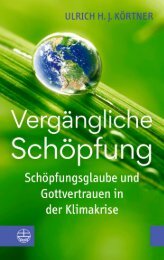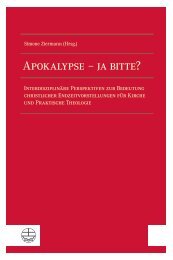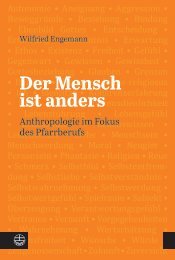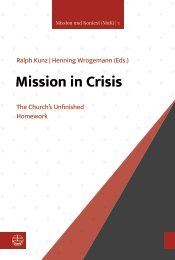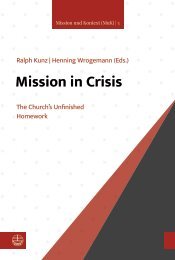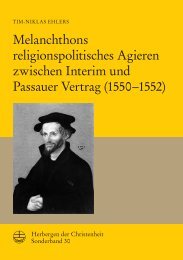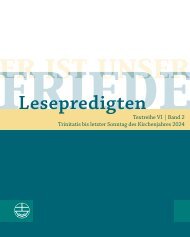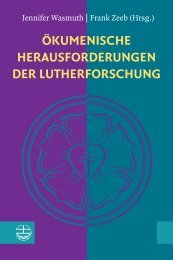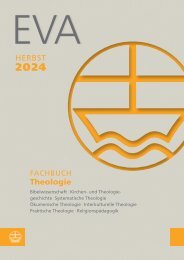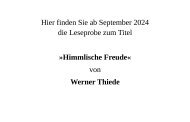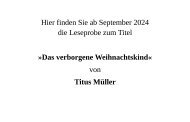Phillip A. Davis, Jr. | Daniel Lanzinger | Matthew Ryan Robinson (Eds.): What Does Theology Do, Actually? (Leseprobe)
Create successful ePaper yourself
Turn your PDF publications into a flip-book with our unique Google optimized e-Paper software.
40<br />
Anja Block<br />
troduced in local churches for liturgical and personal use in 2016. 3<br />
Moreover,<br />
Luther insisted on bringing central points of doctrine back into focus, which can<br />
be summarized in the so-called four soli: Humankind receives and knows about<br />
God’s benevolence only sola fide, sola gratia, solus Christus and sola scriptura.<br />
The latter constitutes one of the main principles of Lutheran doctrine that has<br />
shaped and continues to shape German Protestantism to this day: sola scriptura ---<br />
only scripture is the source of faith. The great Protestant interest in researching<br />
the biblical texts as a source of faith is thus a natural consequence of the principle<br />
of sola scripture. Although the methods of historical-critical research were<br />
developed in the 18 th and 19 th centuries, their foundation lies in the principle of<br />
sola scriptura. 4<br />
It is not surprising that the knowledge of the texts that comes with translating<br />
them led to further research. Translating a text means to read it very closely<br />
and to be familiar with its expressions and meanings. I cannot dive into the history<br />
of historical-critical exegesis in this chapter, but undeniably, observations<br />
and important remarks about the biblical texts and notes about textual history<br />
were part of the process of the text’s transmission. One thinks, for example, of<br />
the medieval Masoretes who noted variants in the Masorah, or of the Jewish-<br />
Dutch philosopher Baruch de Spinoza who was among the earliest of modern<br />
thinkers to ask who might have been the authors of biblical texts.<br />
Yet, it is no less surprising that birth of what we call historical-critical exegesis<br />
occurred between the Enlightenment and Pietism. Rational thought and a<br />
new-found appreciation for the Bible came together and let scholars ask various<br />
questions. Often, the name of Johann Philipp Gabler (1753---1826) is mentioned<br />
in this context, for he distinguished biblical studies from dogmatics and systematic<br />
theology in his De justo discrimine theologiae biblicae et dogmaticae<br />
regundisque recte utriusque finibus in 1787. 5<br />
Following this notion, scholars<br />
asked manifold historical and literary questions about the Bible. They searched<br />
for answers and came up with theories about the development of the biblical text<br />
and the canon. Scholars researched the form and function of biblical texts, historical<br />
events, and their influence on Israelite theology and emerging Christianity.<br />
They searched for explanations for miracles and used reason as a measure for<br />
biblical stories.<br />
3<br />
Cf. Heinrich Bedford-Strohm, ‘‘Die Lutherbibel und das Reformationsjubiläum,’’ in Die<br />
Revision der Lutherbibel 2017: Hintergründe ---- Kontroversen ---- Entscheidungen, ed. Hannelore<br />
Jahr, Christoph Kähler and Jürgen-Peter Lesch (Stuttgart: Deutsche Bibelgesellschaft,<br />
2019), 282f.<br />
4<br />
Cf. Hans-Joachim Kraus, Geschichte der historisch-kritischen Erforschung des Alten Testaments,<br />
3rd ed. (Neukirchen-Vluyn: Neukirchener Verlag, 1982), 8.<br />
5<br />
Cf. Johann Philipp Gabler, Oratio de justo discrimine theologiae biblicae et dogmaticae<br />
regundisque recte vtriusque finibus (Altdorf: Monath, 1787).



